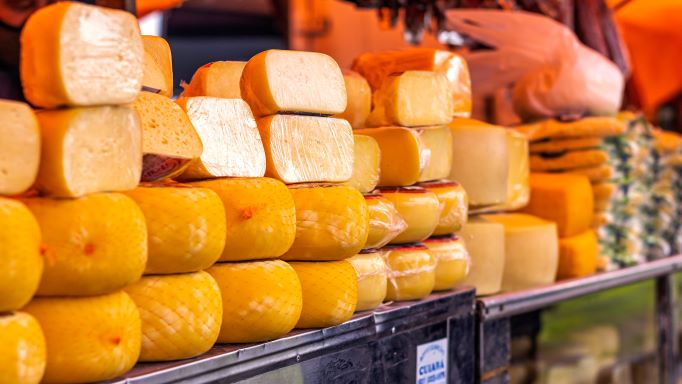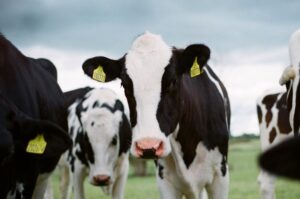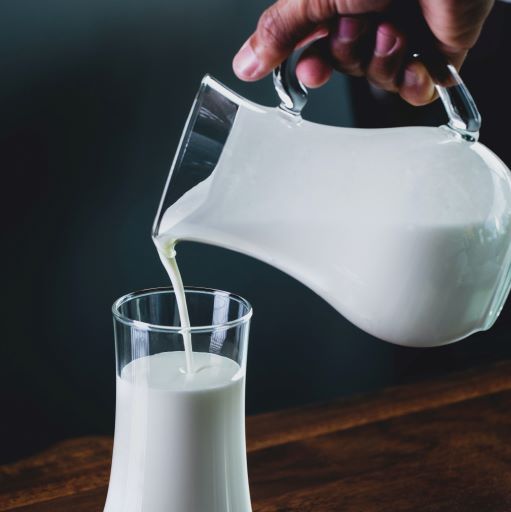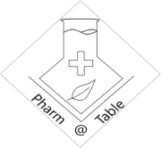“Walking past the ice cream aisle is a different experience. Instead of seeing delicious frozen treats, all you see is a one-way ticket to pain.”
– The Experience of a Lactose Intolerant Shopper
What’s The Story?
What is Lactose Intolerance
According to the National Institutes of Health, people who experience lactose intolerance (LI) are unable to digest the sugar – called lactose – found in milk and other dairy foods. These folks can experience stomach pain, gas, diarrhea, and bloating.
How Common Is Lactose Intolerance?

Roughly two-thirds (68%) of the world’s population and one-third (36%) of the people in the United States have some difficulty digesting lactose sugar. Among ethnic groups, LI is least common among people with European ancestry.
The Difference Between Lactose Intolerance and Milk Allergy
LI is caused by an inability to digest the sugar found in milk. A milk allergy is a more serious condition.
Milk allergies are usually discovered while someone is a baby. It is caused by the protein found in milk. If your body believes the milk protein is harmful, then it will attack the protein. This causes a serious allergic reaction called anaphylaxis. The symptoms include hives and difficulty breathing. Because of this, anaphylaxis may be life threatening.
Do not attempt to eat dairy products if you have a milk allergy. If this describes your symptoms, you should speak to your healthcare provider.
How to Fix Lactose Intolerance
Coming up in this article we’ll talk about the 5 ways you can tackle milk related problems.
These are:
- Lactase Enzymes
- Probiotics
- A Dairy Challenge
- Lactose-Free Dairy Foods
- Non-Dairy Alternatives
Up ahead, I’ll discuss the success I had treating a patient who experienced severe lactose intolerance. Although there’s not enough evidence to say you can cure lactose intolerance completely, my patient is now able to enjoy small amounts of dairy without having to run to the bathroom.
How to Combat Lactose Intolerance
Can You Reverse Lactose Intolerance?
LI can’t be reversed. Not really. Because for most of us, lactose intolerance is genetic.
We do not have the technology to change our genes. But, it can be well managed. In fact, many people do not need to remove dairy from their diets. So check out these suggestions for keeping your stomach happy while munching on milk snacks.
Lactase Enzyme
The enzyme that breaks apart milk is called lactase. Fortunately for us, there are products available over-the-counter to replace this enzyme. Lactase products come in regular tablets, chewable tablets, and powder. Most kinds of tablets are taken 5-30 minutes before eating milk products because it will provide the body with a temporary ability to digest dairy.
I recommend trying fast-acting tablets. Take these with your first bite of dairy foods because it is not necessary to wait for them to kick-in. After taking a tablet, you can continue to eat dairy for up to 45 minutes.
Probiotics
Probiotics are known as “good bacteria”. These incredible bacteria live in our guts. They help us process the food we eat and can even supply us with nutrients that our bodies can not make on their own. If you would like to learn more about probiotics, then check out this article.
There is evidence that probiotics can treat the symptoms associated with lactose intolerance. However, it depends on the bacterial strain and species used. Research suggests several species have been effective. However, the data is strongest for these three species: lactobacillus, S. thermophilus, and bifidobacterium.
Probiotics can be bought in capsules that you can swallow like typical pills. Some foods contain good bacteria strains so eating probiotics is also an option. More on that in a coming section.
Continued research for using probiotics in this way is needed. However, based on what data are available, I recommend using a probiotic for at least four weeks to two months.

Dairy Challenge
In medicine, a “challenge” is slowly giving bigger doses of something to study how a patient will handle it. In this case, that something is milk.
A study described giving an increasing amount of lactose to patients over a 10-day period. The amount of lactose started out low then increased a little bit every other day. At the end of the study, patients reported decreased LI symptoms and increased ability to tolerate a large test-dose of milk.
The scientific evidence for this approach is considered poor. That is because limited studies have been conducted to evaluate this method. In fact, for every study that claims a challenge works, there is another that claims this method does not work.
Lactose Free Lifestyle
How to Fix Lactose Intolerance
It is important to remember there is no certain way to fix lactose intolerance. However, here are some ways you can make sure the symptoms do not interrupt your day.
Lactose-Free Dairy Foods
Eating lactose-free dairy food is a good way to enjoy the benefits of milk without the side-effects caused by lactose.
Yogurt has good bacteria in it which means it is a naturally low-lactose or lactose-free food. Some studies suggest that eating yogurt may actually help with symptoms of LI.
Aged, hard cheeses such as sharp cheddar and parmesan do not usually contain lactose. Basically the longer a cheese has been aged, the less lactose it has.
Dairy foods treated with the lactase enzyme have all the fun of dairy treats without the side effects. Examples of these foods include milk, ice cream and other frozen treats. Fortunately they are now widely available, so check your grocery store.

Non-Dairy Solutions
If you prefer to avoid dairy all together, we are living in a great time to go dairy free. Almost anything you can think of now has a cow-less substitute.
Some examples include:
- Butter: replace butter with cooking oils and vegetable spreads. Some of these taste just like the real thing! (Without the upset stomach)
- Ice cream: try sorbet and sorbetto for an ice cream replacement. Still craving something creamy? Coconut, peanut, and cashew based ice creams are great alternatives.
- Milk: if you’ve wandered into a coffee shop in the last decade I’m sure you’ve seen all the possibilities. There’s oat, almond, rice, soy, and coconut milk just to name a few.
- Cream: coconut cream and cashew cream are two fine replacements for the dairy version. Recently, I’ve even seen other processed, vegetable replacements in the grocery store.
The Dairy Experiment
How I Helped Someone with Lactose Intolerance
The patient I helped suffered with symptoms for years. They were unable to consume any amount of dairy without the use of a lactase enzyme pill.
To complete this experiment I combined two methods I discussed earlier. First, I used probiotics. Then I tried a dairy challenge.
Probiotics First
The probiotic used was a strain in liquid yogurt called lactobacillus casei. The yogurt was taken once daily for 2 months without consuming any other dairy. This was done in the hope of colonizing the gut with the good bacteria. The use of probiotics even continued during the dairy challenge.
Dairy Challenge
The challenge started with 60 mL (about ¼ of a cup) of milk daily for 3 days. Then increased to 120 mL (about ½ cup) for 3 days. Then finally 240 mL (about 1 cup) of milk per day. The patient did not experience any noticeable symptoms of lactose intolerance.
Please note:
No studies have been published that prove using the method I discussed works. This test was based on my opinion which was guided by the evidence I studied while preparing to write this article. What does that mean? Just because it worked for the person I helped, does not mean it is guaranteed to work for everyone.
Curious to try this method? I am a big fan of the expression ‘start low, and go slow’. Doing so may increase the chances of a successful challenge.
If you experience symptoms of LI, try a smaller amount of milk. And if you don’t notice any improvement, consider starting again using a different probiotic strain.
What works for your body may not work for everyone. We are complicated animals.
Final Thoughts
A cure for lactose intolerance does not truly exist. However, trying out some of the steps in this guide may make eating dairy products a more comfortable experience. Hopefully you will be able to reduce the need to take medications or avoid dairy completely. At the end of the day, a better quality of life is what we’re all looking for.
Research for more permanent ways to fix or cure lactose intolerance is still happening. But the science available now is poor in quality. As always, talk to your healthcare provider if you’re concerned or your symptoms are difficult to manage.
Talk Nerdy to Me (Details for Professionals and Curious Minds)
Lactose Intolerance: Clinical Pearls
Lactose is a disaccharide common to the human diet. It is typically found only in mammalian milk making it a relatively rare oligosaccharide in nature. Beta-galactosidase, colloquially referred to as lactase, is the enzyme responsible for catalyzing the hydrolysis of lactose into its constituent monosaccharides. Lactose intolerance (LI) is the name of the clinical condition caused by lactose malabsorption. Symptoms of LI are caused by the fermentation of unhydrolyzed lactose by gut microflora. Most LI individuals retain the ability to tolerate about 5 g of lactose per serving. For reference, milk contains approximately 1 gram of lactose per 20 mL.
Mechanisms for Lactose Intolerance
Symptomatic LI appears to have two distinct mechanisms.
Hypolactasia
Hypolactasia, an autosomal recessive genetic trait. In humans, lactase production begins to decline in infancy. This non-persistence naturally downregulates the production of lactase enzymes. However, only 50% of the production of normal lactose levels is enough to allow for digestion. Among various ethnic groups, non-persistence is seen least commonly among northern Europeans with a frequency of 2-20%. It is observed most frequently among Asians with a frequency of approximately 90%. Among people of European ancestry, a single nucleotide polymorphism is the causal link between the ability to digest lactose or not.
Bacterial Colonization
The other mechanism for LI symptoms is a lack of beta-galactosidase bacteria which colonize the gut and allow for exogenous digestion of lactose. For this reason, people who suffer from lactose malabsorption but have a healthy population of these bacteria may not exhibit symptoms of LI. The evidence for this appears at times contradictory. Several studies have found that the dietary application of these bacteria do not improve overall symptoms of LI. However, some leading experts have found that the evidence for improved lactose digestion is sufficient. Per the European Food Safety Authority, yogurt with more than 10^8 colony-forming units (CFU) of bacteria per gram of product support the health claim that it could improve lactose digestion.
References
- Definition & Facts for lactose intolerance. National Institute of Diabetes and Digestive and Kidney Diseases. https://www.niddk.nih.gov/health-information/digestive-diseases/lactose-intolerance/definition-facts. Accessed August 20, 2022.
- Mousan G, Kamat D. Cow’s Milk Protein Allergy. Clin Pediatr (Phila). 2016 Oct;55(11):1054-63. doi: 10.1177/0009922816664512. Epub 2016 Aug 31. PMID: 27582492.
- Fassio F, Facioni MS, Guagnini F. Lactose Maldigestion, Malabsorption, and Intolerance: A Comprehensive Review with a Focus on Current Management and Future Perspectives. Nutrients. 2018;10(11):1599. Published 2018 Nov 1. doi:10.3390/nu10111599
- Lactose intolerance faqs. LACTAID®. https://www.lactaid.com/frequently-asked-questions#is-it-safe-to-take-lactaid-dietary-supplements-daily. Accessed August 20, 2022.
- Hertzler SR, Savaiano DA. Colonic adaptation to daily lactose feeding in lactose maldigesters reduces lactose intolerance. Am J Clin Nutr. 1996;64(2):232-236. doi:10.1093/ajcn/64.2.232
- Shaukat A, Levitt MD, Taylor BC, et al. Systematic review: effective management strategies for lactose intolerance. Ann Intern Med. 2010;152(12):797-803. doi:10.7326/0003-4819-152-12-201006150-00241
- Facioni MS, Raspini B, Pivari F, Dogliotti E, Cena H. Nutritional management of lactose intolerance: the importance of diet and food labelling. J Transl Med. 2020;18(1):260. Published 2020 Jun 26. doi:10.1186/s12967-020-02429-2
If you have questions about the information or products mentioned in this article, you can always contact us.


I don’t know what I would do without ice cream in my life!
It’s a a lonely world without something sweet to look forward to!
Pingback: Know Your Roots: the Health Benefits of Turmeric - Pharm @ Table
Informative and precise! Great article, thank you for educating!
Thanks for taking time to comment! My goal is provide a free medical resource to anyone. I’ll keep the content coming.